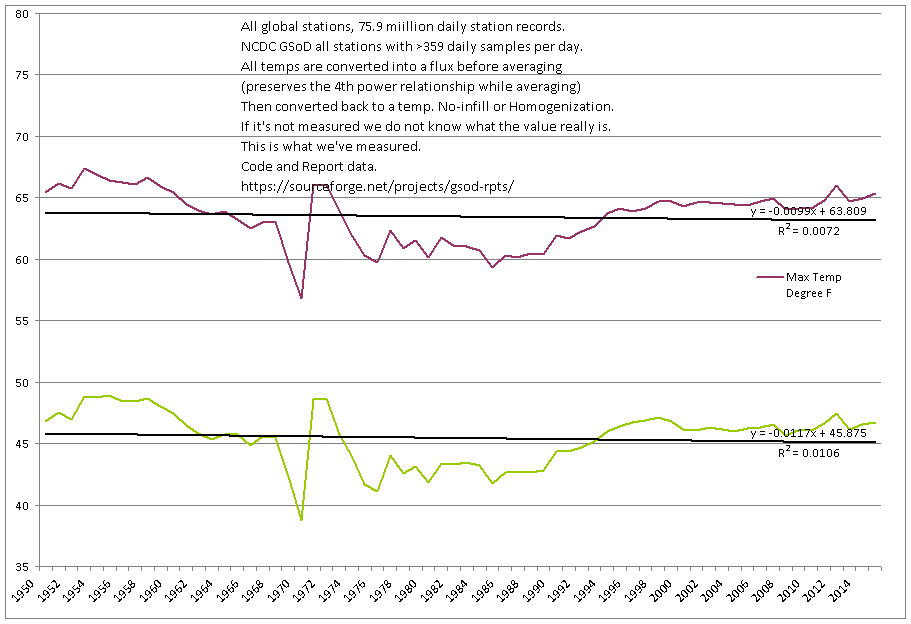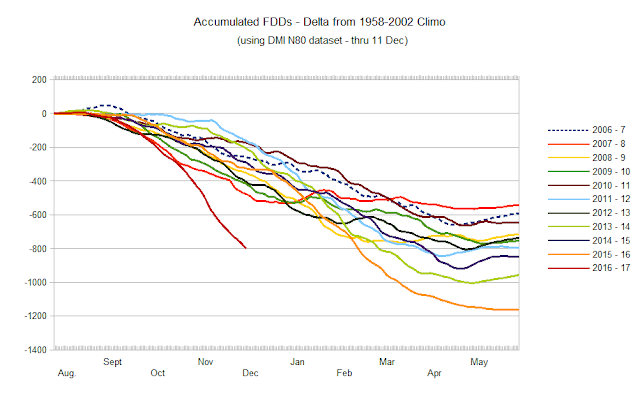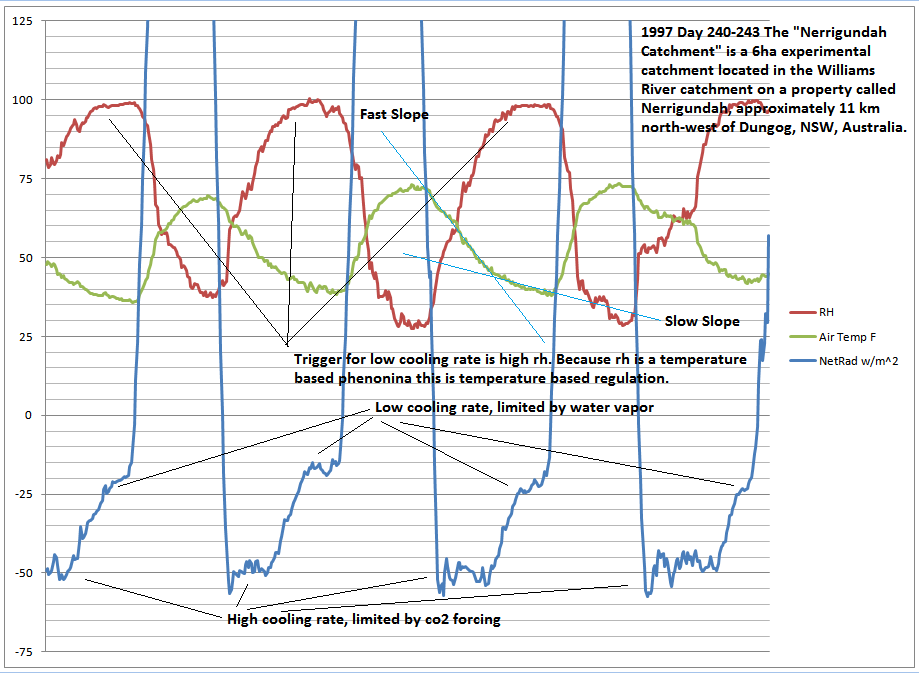From UC Berkeley Earth comes this paper that tries some new statistical techniques to get “the pause” to go away, following on with the infamous Karl et al paper of 2015, that played tricks with SST measurements done in the 40’s and 50’s to increase the slope of the warming. This aims to do the same, though the methods look to be a bit more sophisticated than Karl’s ham-handed approach. The paper link is below, fully open sourced. I invite readers to have a look at it, and judge for yourselves. Personally, it looks like ignoring the most current data available for 2016, which has been cooling compared to 2015, invalidates the claim right out of the gate.
If a climate skeptic did this sort of stuff, using incomplete data, we’d be excoriated. yet somehow, this paper using incomplete data gets a pass by the journal, and publishes with 2015 data at the peak of warming, just as complete 2016 data becomes available.
The results section of the paper say:
From January 1997 through December 2015, ERSSTv3b has the lowest central trend estimate of the operational versions of the four composite SST series assessed, at 0.07°C per decade. HadSST3 is modestly higher at 0.09°C per decade, COBE-SST is at 0.08°C per decade, whereas ERSSTv4 shows a trend of 0.12°C per decade over the region of common coverage for all four series. We find that ERSSTv3b shows significantly less warming than the buoy-only record and satellite-based IHSSTs over the periods of overlap [P < 0.01, using an ARMA(1, 1) (autoregressive moving average) model to correct for autocorrelation], as shown in Fig. 1. ERSSTv3b is comparable to ERSSTv4 and the buoy and satellite records before 2003, but notable divergences are apparent thereafter.
What’s missing? Error bars showing uncertainty. Plus, the data only goes to December 2015. They’ve missed an ENTIRE YEAR’s worth of data, and while doing so claim “the pause” is busted. It would be interesting to see that same graph done with current data through December 2016, where global SST has plummeted. Looks like a clear case of cherry picking to me, by not using all the available data. Look for a follow up post using all the data.
Here’s what the world’s sea surface temperature looks like at the end of 2016 – rather cool.
Compare that to December 2015, for Hausfather’s end data period – they ended on a hot note:
I did ask Zeke Hausfather, the lead author about this paper via email, about it and the data, and to his credit, he responded within the hour, saying:
Hi Anthony,We haven’t updated our buoy-only, satellite-only, and argo-only records to present yet (then still end January 1st 2016), but we are planning on updating them in the near future.
By the way, the paper itself is open access, available here: http://advances.sciencemag.org/content/3/1/e1601207.full.pdf+htmlWe also have a background document we put together here: http://www-users.york.ac.uk/~kdc3/papers/ihsst2016/background.htmlI’m attaching the data shown in that figure. All series have been masked to common coverage (though we we do three different variations of tests for coverage effects, as we discuss in detail in the paper).The data are:acci97Mm.temp – Satellite radiometer record from 1997 (from ATSR and AVHRR)buoy97Mm.temp – Buoy-only record from 1997cobe97Mm.temp – COBE-SST (Japanese record)had97Mm.temp – HadSST3v3_97Mm.temp – ERSSTv3bv4_97Mm.temp – ERSSTv4We start in 1997 because prior to that there is insufficient data from buoys to get a global estimate, and satellite data is only available from mid-1996.Hope that helps,-Zeke
I have made the data available here in a ZIP file (17KB)
That’s how science should work, sharing the data, but I contend that the data should be updated in the paper before publishing it. A year long gap, with a significant cooling taking place, is bound to change the results. Perhaps this is an artifact of the slow peer-review process.
But, Zeke should know better, than to allow the word “disproved” in a headline. We’ll see how well his study claims of “pause-busting” hold up in a year without a major El Niño to bolster his case.
UPDATE: Bob Tisdale points out via email that this paper seems to be a manifestation of a guest post at Judith Curry’s a year ago:
A buoy-only sea surface temperature record
In that post, there’s some serious concerns about the buoy data used, from climate Scientist John Kennedy of the UK Met Office
Dear Bob,
You raise some interesting points, which I’d like to expand on a little. I’ve used your numbering.
First, coastal “SST” from drifters can exhibit large variations because there can be large variations in coastal areas. Also, sometimes, buoys wash up on beaches and start measuring air temperature rather than SST. It’s also common to see drifting buoys reporting erratic measurements shortly before they go offline, wherever they happen to be. Occasionally, they get picked up by ships and, for a short period, record air temperatures on deck. This paper goes into some of the problems that ship and drifter data suffer from:
http://onlinelibrary.wiley.com/doi/10.1002/jgrc.20257/full
Second, drifter design was standardised in the early 1990s. Since then, the only major change I know of has been in the size of the buoys: modern mini drifters are smaller than their non-mini predecessors. Different manufacturers make buoys to the specifications laid down in the standard design. Metadata for buoys is not especially easy to get hold of (for ships there’s ICOADS and WMO publication 47), but work is ongoing to organise the metadata and to see if there are measurable differences between drifters from different manufacturers. Work has also been done to fit a small number of drifters with higher-quality thermometers alongside the standard thermistor. See e.g.
http://journals.ametsoc.org/doi/abs/10.1175/2010JTECHO741.1
The results suggest that individual buoys can exhibit a variety of problems. On average, though, they seem to be unbiased relative to the true SST. Individually, they are higher or lower, with calibrations that vary by a few tenths of a degree.
There can occasionally be large calibration errors (of a degree or more). Nowadays, there is constant monitoring of the drifter network by a number of different centres. Large calibration errors are usually identified quickly. Sometimes these can be fixed remotely, sometimes they can’t and the buoy goes onto a list (see, for example, http://www.meteo.shom.fr/qctools/ ). Monitoring of the early data was less thorough.
As a result of the above considerations, everyone who uses drifting buoy data applies some level of quality screening to it. What is generally accepted is that the average drifter makes a much better SST measurement than the average ship (though there are exceptions, of course, in both directions).
Third, I’d note that drifter coverage is not so great prior to 1995 (I think Kevin said the same), so the relative effect of calibration errors would be more pronounced as well as the difficulty of making a solid comparison with fewer data points. I think, more generally, it’s useful to know how consistent the trends are across a variety of periods. As your graphs show, looking at a variety of periods can reveal different aspects of the data.
Fourth, (I think you mistyped HadSST2 when you meant HadNMAT2, or did I misunderstand?). Question: are the coverages of HadNMAT2 and ERSSTv4 in your plot the same? Coverage of NMAT is confined to areas where ships go, and ship coverage has declined somewhat over this period, whereas ERSSTv4 is more or less global.
The closeness with which NMAT and ERSSTv4 should track each other is something to consider also. The ERSST ship adjustment is smoothed so that variations of shorter than a few years (approximately) are not resolved. My understanding of this is that it’s necessary to reduce the effect of random measurement errors on the estimated bias. By smoothing over several years, the effect of random measurement errors average out, so what’s left is largely due to systematic errors (which is good because that’s what they are trying to assess). On the other hand, it means that the method can’t resolve changes in bias that happen faster than that.
Fifth, the uptick in the number of ICOADS SST observations in 2005 coincides with a large increase in the number of drifting buoy data. Depending on the version of ICOADS used, there’s also often a change in the number and composition of observations at the switch from delayed mode to real time. I think for ICOADS 2.5, that’s the end of 2007.
Sixth, don’t forget that there are 100 different estimates of HadSST3 – which together span estimated uncertainty in the bias adjustment – and additional measurement, sampling and coverage uncertainties which can also affect the trends over shorter periods such as the ones being discussed here. In brief, the trend over this period as estimated by HadSST3 is uncertain. The same goes for ERSSTv4: there is an uncertainty analysis (Liu et al. 2015 published at the same time as Huang et al. 2015). One should be wary about drawing conclusions from a comparison based only on the medians.
http://journals.ametsoc.org/doi/abs/10.1175/JCLI-D-14-00007.1
Best regards to one and all,
John Kennedy
One wonders of Hausfather and Cowtan saw this concern, and if they did, heeded it.
Global warming hiatus disproved — again
By Robert Sanders, Media relations
A controversial paper published two years ago that concluded there was no detectable slowdown in ocean warming over the previous 15 years — widely known as the “global warming hiatus” — has now been confirmed using independent data in research led by researchers from UC Berkeley and Berkeley Earth, a non-profit research institute focused on climate change.

After correcting for this “cold bias,” researchers with the National Oceanic and Atmospheric Administration concluded in the journal Science that the oceans have actually warmed 0.12 degrees Celsius (0.22 degrees Fahrenheit) per decade since 2000, nearly twice as fast as earlier estimates of 0.07 degrees Celsius per decade. This brought the rate of ocean temperature rise in line with estimates for the previous 30 years, between 1970 and 1999.The 2015 analysis showed that the modern buoys now used to measure ocean temperatures tend to report slightly cooler temperatures than older ship-based systems, even when measuring the same part of the ocean at the same time. As buoy measurements have replaced ship measurements, this had hidden some of the real-world warming.
This eliminated much of the global warming hiatus, an apparent slowdown in rising surface temperatures between 1998 and 2012. Many scientists, including the International Panel on Climate Change, acknowledged the puzzling hiatus, while those dubious about global warming pointed to it as evidence that climate change is a hoax.
Climate change skeptics attacked the NOAA researchers and a House of Representatives committee subpoenaed the scientists’ emails. NOAA agreed to provide data and respond to any scientific questions but refused to comply with the subpoena, a decision supported by scientists who feared the “chilling effect” of political inquisitions.
The new study, which uses independent data from satellites and robotic floats as well as buoys, concludes that the NOAA results were correct. The paper will be published Jan. 4 in the online, open-access journal Science Advances.
“Our results mean that essentially NOAA got it right, that they were not cooking the books,” said lead author Zeke Hausfather, a graduate student in UC Berkeley’s Energy and Resources Group.
Long-term climate records
Hausfather said that years ago, mariners measured the ocean temperature by scooping up a bucket of water from the ocean and sticking a thermometer in it. In the 1950s, however, ships began to automatically measure water piped through the engine room, which typically is warm. Nowadays, buoys cover much of the ocean and that data is beginning to supplant ship data. But the buoys report slightly cooler temperatures because they measure water directly from the ocean instead of after a trip through a warm engine room.

Hausfather and colleague Kevin Cowtan of the University of York in the UK extended that study to include the newer satellite and Argo float data in addition to the buoy data.NOAA is one of three organizations that keep historical records of ocean temperatures – some going back to the 1850s – widely used by climate modelers. The agency’s paper was an attempt to accurately combine the old ship measurements and the newer buoy data.
“Only a small fraction of the ocean measurement data is being used by climate monitoring groups, and they are trying to smush together data from different instruments, which leads to a lot of judgment calls about how you weight one versus the other, and how you adjust for the transition from one to another,” Hausfather said. “So we said, ‘What if we create a temperature record just from the buoys, or just from the satellites, or just from the Argo floats, so there is no mixing and matching of instruments?’”
In each case, using data from only one instrument type – either satellites, buoys or Argo floats – the results matched those of the NOAA group, supporting the case that the oceans warmed 0.12 degrees Celsius per decade over the past two decades, nearly twice the previous estimate. In other words, the upward trend seen in the last half of the 20th century continued through the first 15 years of the 21st: there was no hiatus.
“In the grand scheme of things, the main implication of our study is on the hiatus, which many people have focused on, claiming that global warming has slowed greatly or even stopped,” Hausfather said. “Based on our analysis, a good portion of that apparent slowdown in warming was due to biases in the ship records.”
Correcting other biases in ship records
In the same publication last year, NOAA scientists also accounted for changing shipping routes and measurement techniques. Their correction – giving greater weight to buoy measurements than to ship measurements in warming calculations – is also valid, Hausfather said, and a good way to correct for this second bias, short of throwing out the ship data altogether and relying only on buoys.

“In the last seven years or so, you have buoys warming faster than ships are, independently of the ship offset, which produces a significant cool bias in the Hadley record,” Hausfather said. The new study, he said, argues that the Hadley center should introduce another correction to its data.
“People don’t get much credit for doing studies that replicate or independently validate other people’s work. But, particularly when things become so political, we feel it is really important to show that, if you look at all these other records, it seems these researchers did a good job with their corrections,” Hausfather said.
Co-author Mark Richardson of NASA‘s Jet Propulsion Laboratory and the California Institute of Technology in Pasadena added, “Satellites and automated floats are completely independent witnesses of recent ocean warming, and their testimony matches the NOAA results. It looks like the NOAA researchers were right all along.“
Other co-authors of the paper are David C. Clarke, an independent researcher from Montreal, Canada, Peter Jacobs of George Mason University in Fairfax, Virginia, and Robert Rohde of Berkeley Earth. The research was funded by Berkeley Earth.
The paper: Assessing Recent Warming Using Instrumentally-Homogeneous Sea Surface Temperature Records (Science Advances)



















